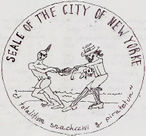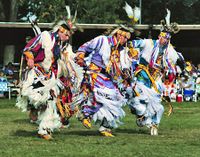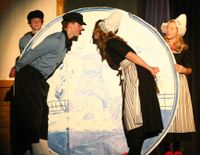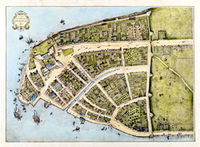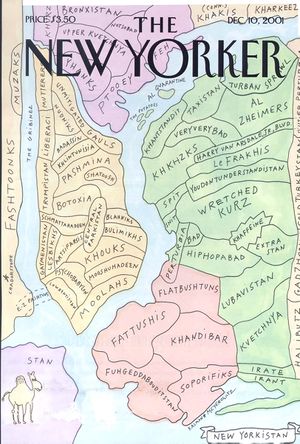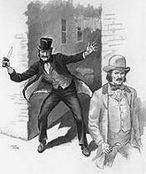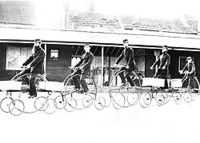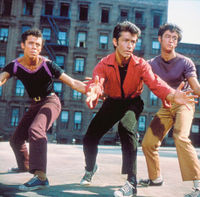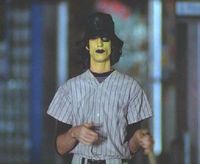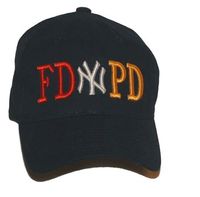User:Zinfandel/New York City
- For some retarded reason, NYC redirects to here. If you want the article for the small village, see Nyc.
| New York City | |
|---|---|
| City | |
| Nickname(s): The Big Unit | |
| Motto: "Dude, did you see that? Those two dudes just jumped outta fucking nowhere and totally fucked that dude up!” | |
| Official language(s) | Cocaine |
| Government | |
| Mayor | “Diamond” Mike Bloomberg |
| Established | 1628 |
| Currency | Hot Dog |
New York City, an anagram of "Wintry Key Co.", is the largest city in North America and most likely the capital of the United States and consenting portions of Quebec. Widely recognized as a powerhouse of pre-Chinese Takeover finance and culture, New York City is regularly highest rated in drug trafficking, terrorist attacks, pornography, rape, murder, and rampaging by large fictional monsters. The city (hereafter, the City, capital “C”) also casts a long, dark shadow over global politics, hosting the headquarters of the United Nations -- many member states of which have 20% or more of their population already living in Queens.
City residents (i.e., the wealthy ones) are known by the demonym “New Yorkers”, though they privately refer to themselves as “Us Guyses”. The City itself has operated under many quasi-official nicknames, most famously “The Big Snapple”, coined in the late 1840s when 75% of its infrastructure is composed of dried fruit and tin. Its all-night pornography kiosks and zealously maintained 24-hour subway system have earned New York the title “The City That Never Sleeps”, later lengthened to “The City That Never Seems To Sleep, And God Does It Show” in reference to former mayor Ed Koch’s deep, skeletal eye sockets and amphetamine usage.
New York City is the sister city of New Bjork City and was honorary “Home of the Whopper” 1971-75, 88.
History[edit | edit source]
Native legends claim the region was first settled in the late bronze age, when a giant turtle drifted into the gulf between Long Island and New Jersey then died. Ancestors of the Lenape American Indians named the turtle corpse Manhattan, one of their 200 near-identical words for “This place just screams ‘party’.” Here the Lanape seem to have thrived in a peaceful, pants-optional society for several centuries prior to European discovery in 1524. Giovanni da Verrazzano, Italian explorer traitorously employed by the French, describes the native population in a letter to His French Majesty Francis I:
“Verily these savages do seem in continual pursuite of merriment; on first estimation we suspected them to communicate in a language composed entirely of back-flips and jovial flatulence. In truth, this was their Ceremony of Taunts, meant for to humble us. Thank Providence, on ship we hadde one troope of Pollack acrobatios, the back-flips and ass-trumpetry of whom are renown. We were thence welcomed as parte unto the tribe and led to partake of their corn whiskey and most cleanly prostitutes. This met me in confound, for I am accustome to being feared as a god: Their lacke of human sacrifices to me did dishearten.”
– Giovanni da Verrazzano, 1524
Da Verrazzano left shortly thereafter, discouraged. European contact ceased for over a century, when in 1614 Dutch sailors on their way to Newfoundland stopped to urinate.
The island of Manhattan was formally purchased from the Lenape by Dutch traders in 1624 with two fur coats and a hammer they swore was "totally magical", and thus was founded the shanty town of Old York. The Lanape continued to live a life of reckless pleasure in the city outskirts that, upon the introduction of European sexual diseases, lead to their rapid demise. In 1627, New York City was built from the ashes of Old York, which was burned to the ground by two shady Dutchmen hoping to collect the insurance. It was in this period of expansion many of modern New York's landmarks were built and named, such as Wall Street, where the Dutchmen briefly considered building a wall, and that weird part of Waverly Place that somehow intersects with itself.
The Dutch gradually realized their funny hats and wooden shoes were out of context in the Americas and sold the island to British settlers desperate to emigrate from recently-founded New Jersey. As British colonists and German Tourists descended upon the young metropolis, and Jersey was relinquished the roving dog packs that have ruled it ever since, its established languages and traditions were interpolated into those of its new tenants, creating the inscrutable New Yorker words and gestures still in wide use today.
As an economic hub of colonial New England, the City grew exponentially from the start of the 18th century up to the early battles of the American Revolutionary War -- the first few years of it, when the colonists were getting their asses handed to them with a regularity. Starting a tradition they would continue through the Civil War and up to Iran Hostage Crisis, New Yorkers saw the surrounding bloodshed as opportunity to assert their independence from any nation and side with the highest bidder (rumored, in 1777, to have been Pope Pius VI).
New York has been the capital of the United States since the end of the revolution, save a brief period in 1951 when Congress was conducted from a constantly airborne Douglas DC10.
The City’s mad growth spurt continued through the early 19th century. The period between 1799 and 1857, later named by William Jennings Bryan “the Big Hot Makeover”, saw many changes that now define the metropolis, such as Central Park and the Plan of 1811, which set future development of the City to a stupidly obvious grid plan that would somehow confound tourists for generations. It was during the Big Hot Makeover that New York gained its reputation abroad as a great-ass place to move to when you’re broke -- wave after wave of Irishmen poured in, staffing the City’s police departments with mustachioed stereotypes for decades to come. These immigrants were followed sequentially by waves of Germans, Chinese, Eastern European Jews, Italians, Chinese (again), and Polish, creating by the dawn of the 20th century a city nearly torn apart by racial strife and exotic dining options.
The next 100 years were characterized by Doo-Wop, the 90s sitcom Friends, and the steady, systematic destruction of every last interesting scrap of soul brought about by the City’s last three centuries. As it stands today, New York City is clean, crime-free, and gloriously indistinguishable from other, more normal American cities like San Diego, California or Columbus, Ohio.
Government & Cityscape[edit | edit source]
New York City is divided into unique governance sectors called “boroughs”, each governed in a top-down feudal model, starting with the City Mayor, then the Boroughmeisters, etc., ending with the various neighborhood vigilante groups who enforce all official and unwritten laws.
Brooklyn, the Bronx and Queens were all cities in their own right until the introduction of the ZIP code in 1963. Whether the two events are related is contested, though the prevailing theory lends much weight to former Bronx Boroughmeister Lemmy Chadwick’s comment at the municipal hearings of June 1962: “What, you think I tell people I’m from the Bronx? Hell farking no, I’m from New York. Makes people think I’m a wealthy ad agent or some shit. Yet as a Quaker, I also feel my soul is corroded by every lie I tell, and therefore welcome even the most asinine excuse to integrate the Bronx into your fine City.”
New York City has at least ten boroughs:
- Manhattan (pop. 1,593,200) - The financial center of the City, Manhattan is the location of many famously depressing metaphors of American decadence: Times Square, the Trump Tower, and the eternally-fenced crater where the World Trade Center once stood and where the Freedom Tower is totally gonna be one day. Manhattan is also home to the New York Knicks Experience and several storied neighborhoods you don't want to be in after sundown, such as Harlem, Spanish Harlem, the Bowery, and Chelsea (see "Gaymanistan", inset).
- Gotham City (pop. Muggers) - Manhattan, between 10pm and 3am. Can you even guess how many people have been stabbed outside that cute M&M's store in Times Square? Only in Gotham, baby!
- Roosevelt Island (pop. 29) - How could it be part of Manhattan if Trader Joe's won't deliver? Originally the location of prisons and mental hospitals, civic-minded 1970s New Yorkers decided to turn the fair isle into a giant park in honor of one of the President Roosevelts. The park never showed up, and the place just now got a Starbucks, but the name sure stuck. Take that, Mr. Presidents!
- The Bronx (pop. 1,364,210 and falling) - Home of Hip-Hop, the Yankees, and the heavily-fortified neighborhood of Riverdale. The only borough of New York not located on an Island, which makes one wonder why it's such an effective prison.
- Queens (pop. 2,256,576) - Filming location for the Spider-Man movies and Coming To America. As the largest borough in area, and the most racially diverse county (it's also a county) in the United States, Queens is home to pizza parlors owned by over 300 non-Italian ethnicities -- a record, of sorts.
- Staten Island (pop. 3,212, as per last census in 1880) - A completely self-sufficient Renaissance-style city-state nobody ever visits or thinks about. Would probably make a better penal colony than the Bronx.
- Shaolin (pop. 8, plus associated parties) - Cash rules everything around this mysterious alternate reality Staten Island governened by Wu-Tang Clan. According to Clan descriptions, Shaolin appears to be antithesis of real Staten -- a dangerous proving ground for kung-fu gangstas, splended yet terrible.
- Kings (pop. lost to time) - Mythical borough that realtors insist can be found, raised from the sea, and repopulated.
- Brooklyn (pop. 2,511,408) - The largest borough by population, the fastest growing contingent of which has taken shape in a soulless army of hipsters. Analysts speculate an alliance between the hipsters in the Williamsburg area and the Yuppies in Dumbo will leave the Marcy Projects completely surrounded by the pale, girly hand of Whitey. Brooklyn watches the moves of rapper Jay-Z carefully -- whether he will return to Marcy in glory, or move into a really fat pad in Dumbo. Also, Coney Island is somewhere near the bottom.
- New Jersey - Now with 20% more sassback!
Citizens[edit | edit source]
New Yorkers are commonly thought to be angry, loud, rude, and hateful. This is based on a gross misunderstanding of their statements and gestures, which are perfectly explicable defense mechanisms necessary for City life. New Yorkers are not the problem -- you are the fucking problem, hot shot.
Yeah, you heard New Yorkers. You -- Mr. Big Stuff Out-Of-Towner, Mr. Tough Guy. You and your two bratty asshole kids: walking around town like you own the place; stopping your whole gaggle of snot-nosed, CoolPix-toting gawkers right in front of the 6-train turnstiles. This may be some jive-ass, glittery fun park to any skidmark from wherever the fuck it is YOU come from, but New Yorkers live here.
Oh you're gonna yell now, make a big fucking scene? Try it, wise guy. New Yorkers can stand here all day, just waiting for you to bring it -- or they can take you outside and show you what it's like. And if you think New Yorkers are joking, just try them -- 'cause they would fucking LOVE it.
That's right, keep walking. Go back home to Wisconsin or Austria or whatever the fuck jerkwater map stain you think's so damn great. New Yorkers don't have time for this shit.
Crime[edit | edit source]
New York City is known for its crime and proud history of criminality, the most auspicious rank of which is street crime -- as New Yorkers have defined it, the only free fun in town.
The earliest recorded street gang dates to the City’s 17th century Dutch roots: as legend has it, within hours of landing on the island, the two brothers Van Donk and their shared common-law wife staked out a half-acre of marshy turf around the modern day intersection of Broadway and Great Jones Street.
Declaring themselves “Der Gangstern Orijn”, the followers and descendents of the Van Donk Boys wrought havoc for the better part of two decades -- no mean feat for a street gang over two miles outside the then city limits. This era of hooliganism, known to historians as Ye Quite Olde Schoole, would last until the American Revolution, when the Continental Army offered the rank of Lance Corporal to any gangster of “adequate street credential.”
The first truly American gangs of the early to middle 19th century, thrived in what is now termed the “Brickbat Era”; motivated by a racist furor we no longer acknowledge in ourselves, colorfully-named gangs of monikered ruffians clashed in ghettos of their day, sporting piecemeal gang uniforms and homemade weapons such as the “whomping pole” or the brick-in-a-sock of the era’s namesake. Nativist gangs like the Kerbstone Pundits or Fisticuff Fellas reigned blows on Irish counterparts such as the Headkicker Boys over scraps of cobblestone turf no larger than a Hardees; men later amalgamated into a single Daniel Day Lewis role won and retained nicknames like “Face-Eater McCann” and “Tommy ‘Three-Nuts’ Kern”, some riding their fame to minor public office.
The era culminated in the Draft Riots of 1863, when psychotic killers from both sides of the ideological divide united to voice their shared, bloodthirsty disdain for federal government. Records are sketchy at best, with an estimated 20 to 100 deaths; yet most historians agree that if the blurry daguerreotypes and sensationalist newspaper depictions are even half-accurate, the Brickbat Era was among the most retrospectively awesome in City history.
Experts pinpoint the end of the Brickbats with the introduction of baseball to New York, which brought with it the time-honored weapon, the baseball bat. Far more wieldy than a clutched brick, the sleek aerodynamics of a Louisville Slugger helped even the daintiest thugs to strike several thumps-per-minute (TPM) faster than stump-hewn clubs of old.
And thus, the Pennyfarthing Era of New York street crime, which thrived in the self-explanatory Gay Nineties of the late 19th century. Progenitors of modern biker gangs, dapper young men patrolled New York streets on their old-timey bicycles and velocipedes, seeking the satisfaction of a vigorous duel.
The Pennyfarthing Gangs were the first to be college educated; though they continued to mug and harass in spite of steady marriages and jobs, by the first world war even the dreaded Straight-Razor Dandies were indistinguishable from the more violent barbershop quartets of that time.
As the organized and infinitely filmable mobs took over the City, the 20th century saw New York street crime into maturity; the hardscrabble gangs had, in a sense, graduated from Hard Knocks U. -- no longer les enfant terribles of global thuggery, but qualified authorities.
New Yorkers focused their once random brutality and made the City's alleys and subway platforms into the world's petty crime runway: the Milan or Paris of hooligan fashion. Major stylistic advancements, such as the swanky zoot suit-clad Harlem Hoodlum period of the early 40s or syncopated dance-brawls of late 50s Puerto Rican gangs, sent shockwaves through the under-policed streets of the world.
Neck-breaking New York innovation continued at its eponymous pace, developing the dramatic costumes and themes to their logical ends; the "SoHo Riots" of 1981, and its cast of coked-out, over-the-top costumed lunatics, set almost impossible new standards for both bloody nihilism and performance art, as one retired thug remembers:
“Yeah man, I was in the Deconstructionist Furies -- from Morningside, dig? We started jus' some dudes with ice picks an' shit ... but then, like, summer of 79? My man Teke shows up some crazy about Foo-coat and Jacques Derrida, like, bros -- shit's collapsing under the weight of a self-referencial eliteist narrative. Next thing, we shavin' our heads to look like Statue of Liberty, wearin' yellow raincoats and combat boots. Whole fuckin' city into that shit! An' really, where you go from there? Once you got your teeth kick in by some Italian kid dress like Edgar Allen Poe, that GED look real sweet.”
– "Episteme" Shines on post-modern street life
By the late 1980s, the largest, most flamboyant street gangs had shrunk to 10-deep rap posses, while hundreds more promising young criminals lost their lives to the crack wars. In the side-streets of Eastern Europe and Central Asia, new breeds of gut-stabbing human refuse, hyped up on designer drugs and Michael Jackson videos, making New York hoods seem more "O" than "G".
In May of 1997, the anemic remainders of the once-mighty Gramercy Riffs, choked by gentrification, dragged a 39-year-tax attorney into a sparsely attended outdoor press conference and beat the bloody shit out of him; they answered no questions, but plainly stated they would turn themselves into the NYPD at 3:00 PM that day. Commentators declared it the anticlimax to 350 years of thrilling New York street warfare.
Transportation[edit | edit source]
There are 5911 subway lines that stretch from Queens to Hell, but only four of them are operational. As they are enjoyed by old men with armpit odor fetishes, it is advised not to ride after 1 P.M. or you will be robbed. Please take caution when asking for directions to midtown, as hipsters like to give wrong directions and send people into Harlem. Yes, you will get used to the smell.
New York Subway Haiku[edit | edit source]
You sell M&Ms
For your basketball team; but
You are four feet tall
Stop having children
If you’re lady with groceries
Taking up ten seats
9/11[edit | edit source]
On September 11, 2001, al-Qaeda terrorists hijacked two commercial planes and flew them into the World Trade Center's twin towers, destroying the nominally symbollic buildings in what political analysts have called "a desperate plea for attention." A competing theory popularized by the porn-adled masses of the Internet has suggested an alternate perpetrator of the attack -- a leak-proof version of the US government that is sufficiently evil to neatly implode two skyscrapers full of people, yet not quite evil enough to simply knock them over and kill an extra thousand or so.
As an immediate result, New York City became the country's official favorite city. Moved by both a desire to help and a disinclination towards monetary aid, millions of Americans who once arbitarily hated the City and everything it stands for began manufacturing, buying, and wearing tacky hats and t-shirts commemorating the New York Police Depart, Fire Department, and Yankees -- often simultaineously -- and swearing to victimized families they'd "Never Forget".
This interest continued until early 2003, when patriotric trends shifted toward "Support[ing] Our Troops" and suggestions that Americans "Love It or Leave It."
Disaster Preparedness[edit | edit source]
The entire city of New York rests on a huge subterranean roller slide system, enabling it to be jettisoned into the Atlantic Ocean at the push of a button if the need arises. This system, completed in 1951, was to allow authorities to balance the North American continent in the event that Los Angeles spontaneously slides into the Pacific Ocean. However, the threat of sudden jettisoning has proved useful for the rest of the nation to keep New Yorkers in check and prevent them from spreading. The button itself is in Chicago. There are also various bridges to keep the taxi drivers in the city, as they hate tolls; these are designed to detach in a controlled manner should jettisoning become necessary, guiding all outbound New York traffic safely into Hudson Bay and the East River.
Did you know[edit | edit source]
- New York City has survived meteorite impacts, alien invasion, tsunamis, Godzilla, earthquakes, global ice ages, and every other natural catastrophe you can think of; yet a lot of people still choose to live there.
- That New York is the only city in the world that you can buy pet high heeled shoes.
- In a recent survery of New Yorkers, the studies found that 78% of all New York residents believed that Japanese tourists grew on trees.
- Everyone sits on their front steps because they have no back yards.
- Almost all New York residents identify themselves as being homosexual,bisexual or heterosexual.
